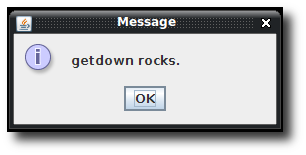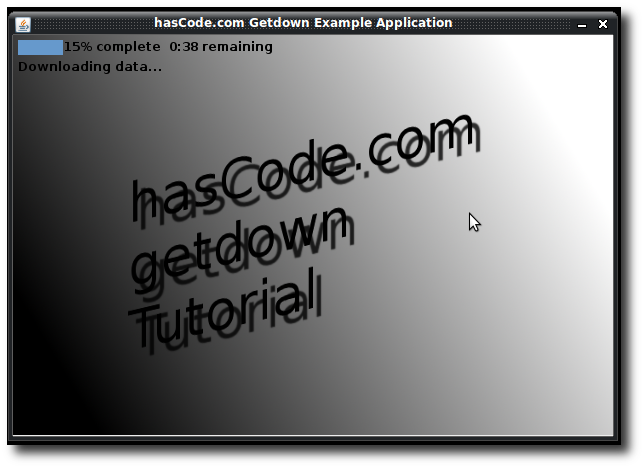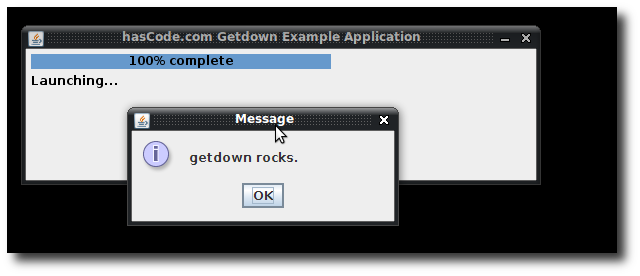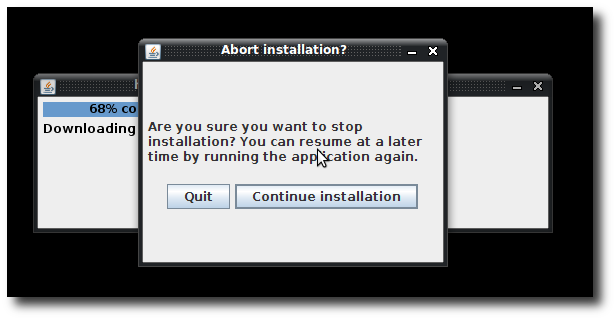Creating updatable Java Applications using Getdown and the Getdown Maven Plugin
May 27th, 2012 by Micha KopsMany programmers have suffered when trying to setup an environment to handle updates for their application without much effort. Some tried Java Web Start for this purpose and many encountered difficulties with this approach.
Now there is getdown that aims to replace Java Web Start by offering a simple architecture to handle updates that is fast, realiable and the only thing you need is a normal http server. Though getdown lets us handle our updates really easy it is possible to make this process even easier with the getdown maven plugin.
In the following example we’re building a simple swing application to be installed, updated and launched using getdown.
Contents
Creating an Application
First of all we need to build an application that may be updated using getdown. For this purpose and to keep it simple we’re using a swing dialog here.
This is my application:
package com.hascode.app; import javax.swing.JFrame; import javax.swing.JOptionPane; public class Main { public static void main(final String[] args) { final JFrame frame = new JFrame("hasCode.com - getdown application"); JOptionPane.showMessageDialog(frame, "getdown rocks."); System.exit(0); } }
Running the application you should be able to see a similar output:
Adding Getdown / the Getdown Maven Plugin
The following dependency adds John Oxley’s getdown maven plugin to the project – it’s using getdown 1.2 underneath (maven: com.threerings:getdown:1.2).
<plugin> <groupId>org.bitbucket.joxley</groupId> <artifactId>getdown-maven-plugin</artifactId> <version>0.0.1</version> </plugin>
Now we need the getdown launcher jar available from the project website – it is used to launch the installation/update/application-run process.
For more detailed information about the concrete process, please take a look at the getdown documentation.
Configuring Getdown for the Project
The following files are important for getdown to load an application and check for updates: a configuration file named getdown.txt, a file that contains the hashes/signatures of the application and important files named digest.txt and of course the application’s jar. Luckily the maven getdown plugin generates the digest file for us so the only the we need here is the getdown.txt and if we wish so – a background image to be used for the downloader.
My getdown.txt in src/main/resources looks like this:
# The URL from which the client is downloaded appbase = http://app.hascode.com/getdown-example/versioned # UI Configuration ui.name = hasCode.com Getdown Example Application ui.background = loader-background.png # Application jar files code = application.jar # The main entry point for the application class = com.hascode.app.Main version=1
There are several other options available but the important ones are these:
- appbase: this is the url where you’ve uploaded your application jar, the digest and the getdown.txt
- version: used to match against the version online (->appbase)
- code: the application jar file
Other options used here are:
- ui.name: this is the title that is displayed in the launcher’s app
- ui.background: this is the file that is used as the launcher’s background image – really helpful here is the fact that the launcher’s size will be automatically adjusted to match the background image’s size.
For a full and more concise documentation of all configuration parameters, please take a look at the getdown documentation.
Deploying and Running the Application
First we need to build the application using our IDE or running..
mvn package
Afterwards there should be several files in the target directory..
target/ |-- application.jar |-- classes | |-- com | | `-- hascode | | `-- app | | `-- Main.class | |-- getdown.txt | `-- loader-background.png |-- digest.txt |-- getdown.txt |-- loader-background.png |-- maven-archiver | `-- pom.properties `-- test-classes
As we can see – the digest.txt has been generated automatically .. if we wished to deploy this build as an updatable application we just needed to upload the application.jar, getdown.txt and digest.txt to a normal webserver.
We’re now able to start the application via
java -jar getdown-client-1.2.jar target/
This is what the launcher looks like without any background image defined:
And this is the launcher with an background image defined (ugly but sufficient):
Finally when the download is finished our application is launched and the launcher window disappears shortly after
In addition, getdown is able to handle user interactions such as to abort the update process
Testing the Update Mechanism
To test the update mechanism just create a new version and upload it to the location specified in your getdown.txt.
If you need to create a bigger file filled with some random content to simulate a bigger download – if you’re using linux or mac then dd is your friend here .. the following command creates a file with a size of 30MB..
dd if=/dev/urandom of=src/main/resources/randomfile bs=30M count=1
Logging
If an error occurs during the installation process then there is a precise log that is written by the getdown launcher in the application directory named launcher.log.
It show important details about the checksum validation, the download process and the environment – if something fails at the customer’s side – this is the file that you’ll want ;)
Tutorial Sources
I have put the source from this tutorial on my Bitbucket repository – download it there or check it out using Mercurial:
hg clone https://bitbucket.org/hascode/getdown-example





May 28th, 2012 at 2:52 pm
Why won’t you stop promoting that trash named maven?
May 28th, 2012 at 7:57 pm
What’s your alternative, “anon”?
May 30th, 2012 at 12:16 am
I don’t think that Maven is a trash. I’ve used it with great success.
Getdown is very nice.
July 25th, 2012 at 8:18 pm
gradle will kill maven in next 9 years :)
(Git & Mercurial will kill SVN in next 5 years)
July 25th, 2012 at 8:41 pm
gradle is nice and has impressed me since I’ve listened to Hans Dockter’s polemic talk on the JAX Conference 2009 .. perhaps I should use it more often in my tutorials :)
and a decade is a long time .. but maven is used quite often so perhaps your prophecy is right :)
April 29th, 2013 at 3:54 pm
Um, I cant seem to download the example?
April 29th, 2013 at 6:47 pm
Thanks for your remark! I’ve added a sample application in zip and tgz format.
April 6th, 2016 at 3:26 pm
It does not work on windows
April 8th, 2016 at 4:55 am
Could you please state it more precisely?
October 20th, 2016 at 10:40 am
Can we update exe files with getdown. I jave my jaf file wrapped as single exe file.
December 5th, 2018 at 10:38 am
what is this “appbase”, is this the repository path. And how this patch working.
December 9th, 2018 at 3:54 pm
It’s the path where you’ll be uploading the artifacts … the location on your webserver..
March 26th, 2019 at 5:21 pm
Would this mechanism work for a client-server web app which the customer installs on their own web server? Currently works using applets or Java Web Start but since both mechanisms have been deprecated we need to find another way?
March 27th, 2019 at 9:14 pm
Regard the latest changes in the Java (Oracle) Licensing you could consider bundling OpenJDK with your Application … also Getdown is still nice, but update4j seems to be worth a look, too … perhaps I could update the article to reflect this fact … see here: https://github.com/update4j/update4j
August 3rd, 2020 at 4:55 pm
How would you download or pass dynamic values in getdown.txt
April 16th, 2021 at 7:54 am
Using getdown 1.8.6 the image is now:
ui.background_image = loader-background.png
Thanks for the little tutorial. I’d add how to run the getdown-launcher here it is:
java -Dappbase=http:/// -jar getdown-launcher-1.8.6.jar my-app
May 2nd, 2021 at 5:32 pm
Thanks for sharing this information! :)
August 23rd, 2022 at 3:00 pm
which would be better
org.bitbucket.joxley
getdown-maven-plugin
or
io.github.rockfireredmoon
getdown-maven-plugin